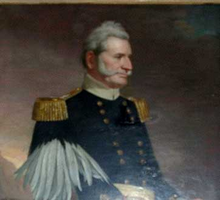Bennett Riley
| Bennet C. Riley | |
|---|---|
 |
|
| 6th Military Governor of California | |
|
In office 1849–1849 |
|
| Preceded by | Richard Barnes Mason |
| Succeeded by | Peter Hardeman Burnett |
| Personal details | |
| Born |
November 27, 1787 St. Mary's County, Maryland |
| Died | June 6, 1853 (aged 65) Black Rock, near Buffalo, New York |
| Resting place | Forest Lawn Cemetery, Buffalo |
| Spouse(s) | Arabella Israel Riley |
| Profession | Soldier |
| Religion | Roman Catholic |
| Signature |  |
| Military service | |
| Allegiance | United States of America |
| Service/branch | United States Army |
| Years of service | 1813–1850 |
| Rank |
|
| Unit | |
| Commands |
|
| Battles/wars | |
Bennet C. Riley (November 27, 1787 – June 6, 1853) was the sixth and last military governor of California. Riley ordered the election of representatives to a state constitutional convention, and handed over all civil authority to a Governor and elected delegates at the end of 1849; the following year, California joined the U.S. as a state. He participated in the War of 1812 on Lake Ontario. He also served in the United States Army during the Seminole War in Florida, and Mexican-American War.
Bennet Riley was born to an Irish-Catholic couple, Bennet Riley and Susanna Ann Drury in St. Mary's, Maryland, 1787. His father apprenticed him to a cobbler; later, he served as a foreman in a shoe factory. After his father's death in 1811, he signed up for service on a privateer.
Riley married Arabella Israel, of Philadelphia, on 9 November 1834, at the Jefferson Barracks, Lemay, Missouri. They had eight children: William Davenport Riley and Samuel Israel Riley, twins, died in Fort King, Florida, on 15 and 17 November 1841; Bennet Israel Riley, born 1835 in Massachusetts, served in the Navy and died aboard the war-sloop USS Albany, which disappeared with all hands in September, 1854; Mary, born 1836; Arabella I. Riley, 1837–1916) (never married); George, born 1838; and Edward Bishop Dudley Riley (1839–1918), whose military career was split between the Union and Confederate armies.
Ulysses S. Grant described Bennet Riley as "the finest specimen of physical manhood I had ever looked upon...6'2 (190 cm) in his stocking feet, straight as the undrawn [sic] bowstring, broad shouldered with every limb in perfect proportion, with an eagle and a step as light as a forest tiger." An accident or injury in his youth caused him to lose part of his palette, and he spoke with a hoarse voice.
Riley volunteered for service in the War of 1812, and on 19 January 1813, he was appointed Ensign of Rifles. In March of the same year, he became a third lieutenant and in April 1814 a second lieutenant in the First Rifles. He saw action at Sackets Harbor, New York, in second of two battles for control of the shipyards on Lake Ontario. He gained a promotion to first lieutenant in March 1817. Riley was further advanced to captain in the 5th U.S. Infantry, and by 1821 he was transferred to the 6th U.S. Infantry.
...
Wikipedia
